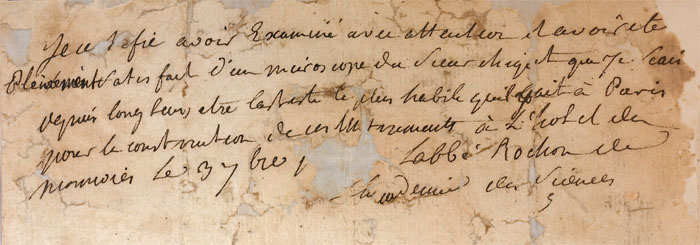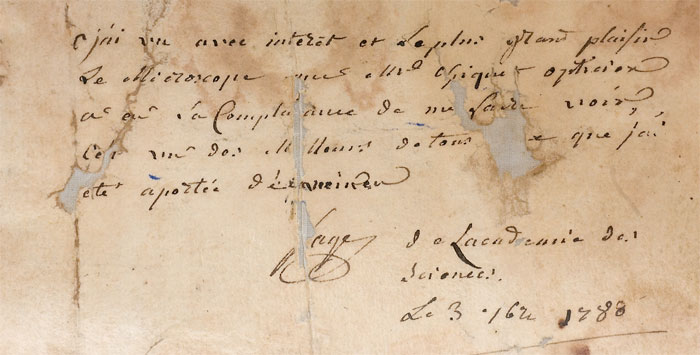

Je certifie avoir examiné avec attention et avoir été pleinement satisfait d’un microscope du Sieur Chiquet que je scais depuis longtems être l’artiste le plus habile qu’il y ait à Paris pour la construction de ces instruments à L’hôtel de Monsieur [Palais-Royal, Monsieur = duc d’Orléans]. Le 3 7bre 1[788] L’abbé Rochon de l’académie des sciences”
"I certify that I closely examined and was fully satisfied with a microscope by Mr. Chiquet, whom I have known for a long time to be the most skilful artist in Paris for the construction of these instruments at the residence of Monsieur [Palais-Royal, Monsieur = duke of Orléans]. The 3rd of September 1788. The abbot Rochon of the Academy of Sciences."
[Abbé Rochon refers to the abbot Alexis Marie de Rochon (1741-1817) who was a member of the French Academy of Sciences. One should not be surprised that Chiquet asked Rochon to examine his microscope, as the latter was very knowledgeable on optics and, more importantly, a member of the Comité des brevets.]
J’ai vu avec intérêt et le plus grand plaisir le microscope que Mo Chiquet opticien a eu la complaisance de me faire voir. C’est un des meilleurs de tous [ceu]x que j’ai été aportée d’examiner
Sage de L’académie des sciences
Le 3 7bre 1788”
"I have seen with interest and the greatest pleasure the microscope that Mr. Chiquet, optician, had the kindness to show me. It is one of the best of all those that have been brought to me to examine."
Sage of the Academy of Sciences
the 3rd of September 1788”
Balthasar Georges Sage (1740-1824) was a chemist/mineralogist and member of the French Academy of Sciences.
Both these documents appear to be certificates for the quality of Chiquet’s microscopes. Maurice Daumas relates in his book that Chiquet used these certificates to ask for a reward from the government in 1791. In fact, Daumas explicitly states that Rochon signed one of these certificates. As the documents that come with Golub’s Chiquet microscope are dated 1788, one may feel entitled to conclude that Chiquet waited for the French Revolution to pass to file his request for government support.